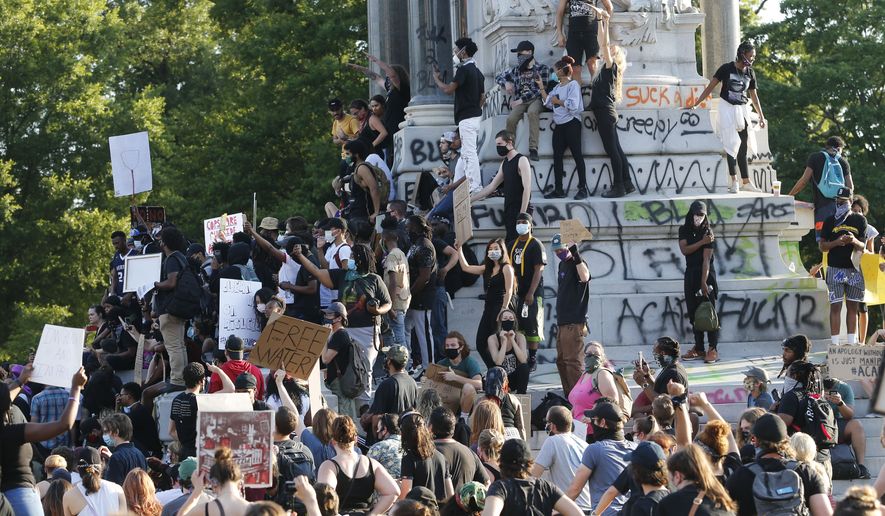A longtime campaign to take down statues memorializing the Confederacy, many of which were erected decades after the Civil War, is gaining newfound momentum amid protests over the death of George Floyd.
Anti-racism sentiments driving the campaign have pushed U.S. elected leaders in several cities and states to remove Confederate monuments and apparently have inspired Belgians to reconsider their country’s colonial past.
Citizens in Belgium are calling for the removal of statues honoring King Leopold II, whose military missions resulted in the deaths of millions of people in the African Congo in the late 1800s to extract its resources, Reuters reported Thursday.
Belgians are expressing solidarity with U.S. protesters demonstrating against the death of Mr. Floyd, a black man who died after a white Minneapolis police officer knelt on his neck for nearly nine minutes on Memorial Day, according to Reuters.
In the U.S., the protests have prompted swift action against Confederate memorials:
⦁ In Richmond, the erstwhile capital of the Confederacy, Virginia Gov. Ralph Northam announced plans Thursday to remove the bronze statue of Gen. Robert E. Lee from the city’s prestigious Monument Avenue as soon as possible.
“You see, in Virginia, we no longer preach a false version of history — one that pretends the Civil War was about ’state rights’ and not the evils of slavery. No one believes that any longer,” Mr. Northam, a Democrat, said at a news conference.
On Wednesday, Richmond Mayor Levar Stoney said he would seek to uproot the statues of other Confederate leaders from Monument Avenue, a National Historic Landmark district.
⦁ In Indianapolis, Mayor Joe Hogsett said the city will remove from Garfield Park a monument dedicated to Confederate soldiers who died at a Union prison camp in the city. He said contractors will dismantle the grave memorial, which was relocated to the park about 100 years ago from its original position in a cemetery.
“Our streets are filled with voices of anger and anguish, testament to centuries of racism directed at Black Americans,” Mr. Hogsett, a Democrat, said in a press release. “We must name these instances of discrimination and never forget our past — but we should not honor them.”
⦁ In Northern Virginia, the United Daughters of the Confederacy on Tuesday removed “Appomattox,” a statue of a forlorn soldier looking southward with his head down and arms crossed from the middle of an intersection in Old Town Alexandria, where it had stood for more than 130 years.
⦁ In Birmingham, Alabama, Mayor Randall Woodfin ordered a crane to pull down the Confederate Soldiers and Sailors Monument on Monday. The monument, which had stood in Linn Park for 115 years, already had been damaged by George Floyd protesters.
Alabama Attorney General Steve Marshall filed a lawsuit against the city Tuesday for violating a 2017 law that bars removal of a monument without state approval and fined Mr. Woodfin $25,000.
Protesters toppled a statue of Robert E. Lee in Montgomery, Alabama, on Saturday, and officials voted to remove a Confederate monument at Battle Park in Rocky Mount, North Carolina.
Controversy has long roiled efforts to take down Confederate symbols. The statues have survived with support from statehouses, town councils and proponents who say the monuments celebrate the heritage of the South and embrace an esprit de corps for anti-governmental attitudes.
In 2018, Alabama Gov. Kay Ivey, a Republican, said that “folks in Washington” and “out-of-state liberals” should not lead the conversation on the monuments’ fate.
“We can’t and shouldn’t even try to change or erase or tear down our history,” Ms. Ivey said. “We must learn from our history.”
A spokesperson for Ms. Ivey declined a request for an interview on the removal of the statue in Birmingham.
Proponents for removing the monuments note that many were erected in the post-Reconstruction era and the Jim Crow and the civil rights eras of the 1950s and ’60s, when the statues symbolized continued oppression of blacks.
Mr. Northam said Thursday that the statues coincided with large-scale efforts to disenfranchise black voters. He said more than 100,000 black men were registered to vote in Virginia in the early years after the Civil War, but that plummeted 90% after the Lee statue was erected in 1890.
“But voting matters. And elections matter. And laws can be changed. And this year … we changed them,” Mr. Northam said.
⦁ This article is based in part on wire service reports.
• Christopher Vondracek can be reached at cvondracek@washingtontimes.com.




Please read our comment policy before commenting.